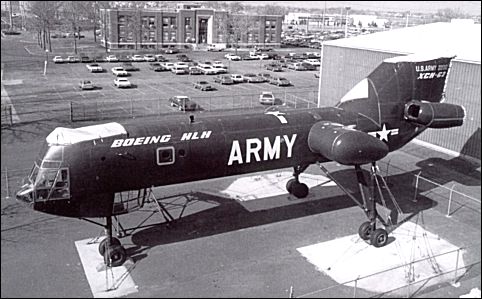|
|
This big "flying crane" built for the US Army's HLH (Heavy Lift Helicopter) specification, was put into storage prior to completion when the programme was cancelled in October 1974. In 1983 plans were initiated to resume the test programme with a possible first flight in 1985. The HLH would be capable of carrying 20 tonnes over a distance of nearly 40km. G.Apostolo "The Illustrated Encyclopedia of Helicopters", 1984
 |
Boeing-Vertol 301 / XCH-62
|
 |
This is the unfinished Boeing Vertol XCH-62 (serial 72-2012), the planned prototype of the Army's HLH program. Note the rear-facing position for the cargo operator and the overall similarity to the Boeing Vertol 107/114 designs for tandem-rotor helicopters
|
 |
This is Boeing Vertol's 347, built to test HLH systems and concepts. A retractable cargo-operator's cockpit facing rearwards was fitted just in front of the forward landing gear.
|
| Technical data for XCH-62
Engine: 3 x Allison T701 turboshaft, rated at 5945kW,
rotor diameter: 28.0m,
length: 27.20m,
height: 8.70m,
take-off weight: 53572kg,
empty weight: 26754kg
|
Warning: mysqli_connect(): php_network_getaddresses: getaddrinfo for mysql5.zone.ee failed: Name or service not known in /data03/virt15346/domeenid/www.aviastar.org/htdocs/helicopters_eng/boeing_hlh.php on line 89
Fatal error: Uncaught mysqli_sql_exception: php_network_getaddresses: getaddrinfo for mysql5.zone.ee failed: Name or service not known in /data03/virt15346/domeenid/www.aviastar.org/htdocs/helicopters_eng/boeing_hlh.php:89
Stack trace:
#0 /data03/virt15346/domeenid/www.aviastar.org/htdocs/helicopters_eng/boeing_hlh.php(89): mysqli_connect('mysql5.zone.ee', 'd14657sa18989', Object(SensitiveParameterValue))
#1 {main}
thrown in /data03/virt15346/domeenid/www.aviastar.org/htdocs/helicopters_eng/boeing_hlh.php on line 89
|





